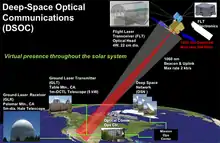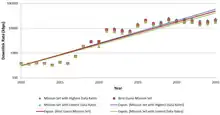Deep Space Optical Communications
Deep Space Optical Communications (DSOC) is a laser space communication system in development meant to improve communications performance 10 to 100 times over the current radio frequency technology without incurring increases in mass, volume or power.[1] DSOC will be capable of providing high bandwidth downlinks from beyond cislunar space.

The project is led by NASA's Jet Propulsion Laboratory (JPL) in Pasadena, California.
Overview
Future human expeditions may require a steady stream of high-definition imagery, live video feeds, and real-time data transmission across deep space to enable timely guidance and updates during the long-distance journeys.[1] Even at its maximum data rate of 5.2 megabits per second (Mbps), the Mars Reconnaissance Orbiter (MRO) requires 7.5 hours to transmit all of its onboard recorder, and 1.5 hours to send a single HiRISE image to be processed back on Earth. New high-resolution hyperspectral imagers put further demands on their communications system, requiring even higher data rates.[2]
The precursor technology demonstration for this optical transceiver is scheduled to launch in 2022 on board NASA's robotic Psyche mission to study the giant metal asteroid known as 16 Psyche. The laser beams from the spacecraft will be received by a ground telescope at Palomar Observatory in California.[3] Laser beams to the spacecraft will be sent from a smaller telescope at Table Mtn, CA.
Design
This new technology will employ advanced lasers in the near-infrared region (1.55 µm[4]) of the electromagnetic spectrum.[1] The architecture is based on transmitting a laser beacon from Earth to assist line-of-sight stabilization and pointing back of the downlink laser beam. In addition, efficient codes are used for error free communications. The system must correct for background noise (scattered light) from Earth's atmosphere and the Sun.[5] The performance of the uplink is expected to be 292 kbit/s at a distance of 0.4 AU.[6] The transmitted beam-width is inversely proportional to the frequency used, so the shorter the wavelength used, the more narrow and focused a beam can be made.[2] The downlink bandwidth will depend on the ground telescope diameter and will be less during daytime.[6]
Three key DSOC technologies developed for the project include:[4][5]
- a low-mass spacecraft disturbance isolation and pointing assembly for operating in the presence of spacecraft vibrational disturbance.
- a high-efficiency flight laser transmitter;
- a pair of high-efficiency photon counting detector arrays for the flight optical transceiver and the ground-based receiver (a telescope).[5]

| Flight laser transmitter | Ground systems |
|---|---|
| Laser: 4 W Wavelength: 1.55 µm | Uplink: • Telescope (1 m) • 5 kW power • Wavelength 1.064 µm |
| Telescope: 22 cm aperture Capable of pointing up to 3 degrees of Sun | Downlink: • 5 m telescope • Operates day or night • Can point within 12 degrees of Sun |
| Mass: <29 kg[6] | |
| Power: <100 W |
Psyche mission
A Deep Space Optical Communication demonstration will be included with NASA's Psyche mission, scheduled for launch in mid-2022. The Psyche spacecraft will explore the metal asteroid 16 Psyche, reaching at the asteroid belt in 2026.[7][8]
References
- Deep Space Optical Communications (DSOC). Jennifer Harbaugh, NASA News 24 October 2017.
- Deep Space Communications. NASA, 2017.
- Hall, Loura, ed. (October 18, 2017). ""Lighten Up" – Deep Space Communications via Faraway Photons". NASA.

- Deep Space Optical Communications (PDF). Tom Glavich, NASA. 28 July 2015.
- Game Changing Development: Deep Space Optical Communications (DSOC) (PDF). Jet Propulsion Laboratory, NASA.
- Deep Space Optical Communications (DSOC) (PDF). Overview Poster. Biswas NASA July 2014.
- David, Leonard (18 October 2017). "Deep Space Communications via Faraway Photons". NASA / Jet Propulsion Laboratory. Retrieved 4 November 2017.
- Greicius, Tony (14 September 2017). "Psyche Overview". NASA. Retrieved 18 September 2017.